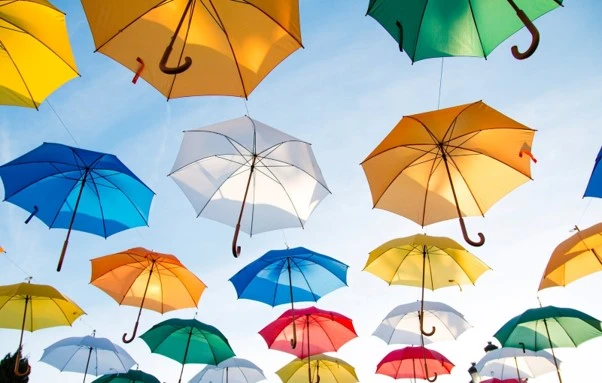
Umbrellas are more than just practical tools for shielding us from rain and sun; they carry rich cultural significance and artistic value across the globe. From their historical use as symbols of authority in ancient civilizations to their modern-day role as customizable promotional items, umbrellas have evolved in both function and meaning. This exploration delves into fascinating trivia about umbrellas, highlighting their symbolism, artistic representation, diverse types, and cultural festivals that celebrate their craftsmanship.
Origin: The term “umbrella” originates from the Latin word “umbra,” which translates to shade or shadow. This etymology reflects the original purpose of the umbrella: to provide shade from the sun. The concept of a canopy for protection against the elements can be traced back to ancient civilizations, where it was common for royalty and the elite to use large, decorative umbrellas as a status symbol. This practice has evolved over centuries, with the umbrella becoming a common accessory for people of all walks of life around the world.
First Use: The earliest known use of an umbrella dates back to ancient Egypt around 3,000 BC. Archaeological findings suggest that these early umbrellas were made from palm leaves or feathers and were used primarily to shield individuals from the harsh sun. Similar sunshades were also found in ancient China and Greece, indicating that the umbrella’s utility transcended cultures. Over time, the design and materials of umbrellas evolved, leading to the more sophisticated versions we use today.
Materials: Traditional umbrellas were often crafted from luxurious materials such as silk, which provided a beautiful yet functional cover. In contrast, modern umbrellas typically use synthetic materials like nylon or polyester, which are lightweight, durable, and water-resistant. The frame of umbrellas has also evolved, with materials like fiberglass and aluminum being used for their strength and flexibility. This shift in materials has made umbrellas more accessible and practical for everyday use, allowing them to withstand various weather conditions.
Oldest Umbrella: The oldest surviving umbrella, believed to be over 2,000 years old, was discovered in China, showcasing the long history of this accessory. This ancient umbrella was made from materials available at the time, likely bamboo and silk, demonstrating the craftsmanship of early artisans. The preservation of such an artifact offers invaluable insights into the cultural practices and daily life of ancient civilizations, highlighting the importance of umbrellas not just as functional items but also as symbols of status and protection.
Largest Umbrella: The largest umbrella in the world, known as the “Umbrella of the Sun,” is located in Las Palmas, Gran Canaria. This impressive structure measures 28 meters (approximately 92 feet) in diameter, making it a significant architectural feature in the area. Designed to provide shade for visitors in public spaces, this giant umbrella is not only functional but also an eye-catching piece of art. It showcases the versatility of umbrella design, extending beyond personal use to serve larger communities.
Smallest Umbrella: The smallest umbrella measures just 10 centimeters (about 3.9 inches) when closed, specifically designed for miniature dolls. This tiny umbrella is a testament to the creativity and craftsmanship involved in miniature design, often used in dollhouses or as collectibles. The precision required to create such a small functional item highlights the skill of artisans who specialize in miniatures, making it a fascinating piece for collectors and enthusiasts alike.
Most Expensive Umbrella: The title of the most expensive umbrella in the world goes to the “Swarovski Crystal-Studded Umbrella,” valued at $50,000. This luxurious accessory features thousands of hand-set Swarovski crystals, making it not only a functional item but also a statement piece of fashion. The umbrella is often seen as a symbol of opulence and exclusivity, appealing to those who appreciate high-end accessories. Its price reflects the craftsmanship and materials involved, showcasing how umbrellas can transcend their practical use to become luxury fashion items.
Rainfall Protection: A typical umbrella can protect against approximately 90% of rain when used correctly, making it an essential accessory in rainy climates. The effectiveness of an umbrella depends on its size, design, and the angle at which it is held. Larger umbrellas generally offer more coverage, while those with a vented design can reduce wind resistance, preventing them from turning inside out. This high level of protection has made umbrellas a popular choice for people looking to stay dry during unexpected downpours.
Wind Resistance: The best wind-resistant umbrellas are designed to withstand winds of up to 70 mph (113 km/h). These umbrellas feature reinforced frames and vented canopies that allow wind to pass through rather than exerting pressure on the structure. This design innovation is crucial for maintaining the integrity of the umbrella during storms or windy conditions, ensuring that users can rely on their umbrellas even in challenging weather. Such umbrellas are particularly popular among outdoor enthusiasts and those living in windy regions.
Invention of the Folding Umbrella: The folding umbrella, a modern convenience that allows for easy portability, was invented in 1928 by Hans Haupt. This innovation revolutionized the umbrella industry, making it more accessible for everyday use. The folding mechanism allows the umbrella to collapse into a compact size, fitting easily into bags or purses, which has made it a staple accessory for people on the go. Prior to this invention, umbrellas were typically large and cumbersome, making them less practical for everyday use. Haupt’s design paved the way for a variety of styles and functionalities, leading to the development of compact, lightweight umbrellas that can be carried effortlessly. This transformation in umbrella design has contributed to their widespread popularity, as consumers value both convenience and functionality in their accessories.
Umbrella Etiquette: In Japan, it is considered rude to open an umbrella indoors, as it is believed to bring bad luck. This cultural belief is rooted in traditional superstitions, where opening an umbrella inside is thought to invite misfortune. As a result, many Japanese people are careful to follow this etiquette, often waiting until they are outside to open their umbrellas, regardless of the weather conditions. This practice reflects the broader cultural emphasis on harmony and respect for one’s surroundings, showcasing how even everyday items like umbrellas can carry significant social meaning.
Color Psychology: Black umbrellas are the most popular color choice among consumers, as they are often associated with elegance, sophistication, and practicality. The neutral tone of black complements various outfits, making it a versatile accessory for both formal and casual occasions. Additionally, black umbrellas tend to show less dirt and wear over time compared to lighter colors. While black is the preferred choice, umbrellas come in a wide range of colors and patterns, allowing for personal expression and style. Brightly colored or patterned umbrellas can also serve as a cheerful accessory on gloomy, rainy days.
Umbrella Ribs: Most umbrellas feature 8 to 16 ribs that provide structure and support to the canopy. These ribs, typically made from materials such as fiberglass or metal, are crucial for maintaining the shape and stability of the umbrella when it is opened. The number of ribs can affect the umbrella’s durability and wind resistance; more ribs generally provide better support and strength. The design of the ribs also influences the ease of opening and closing the umbrella, with many modern umbrellas incorporating automatic mechanisms for convenience. The engineering behind these components plays a significant role in the overall performance of the umbrella.
Umbrella History: In ancient Greece, umbrellas were primarily used by women as sunshades, while men often used them for protection against rain. This gender distinction in usage highlights the cultural norms of the time, where women were more frequently associated with domestic roles and outdoor leisure activities. The Greeks crafted umbrellas from materials like papyrus and leather, showcasing their craftsmanship. Over the centuries, the use of umbrellas expanded across different cultures, evolving into a common accessory for both genders, reflecting changing societal norms and the practical needs of individuals.
The Umbrella Academy: “The Umbrella Academy” is a popular comic book series created by Gerard Way, which has also been adapted into a successful Netflix show. The story revolves around a dysfunctional family of adopted superhero siblings who reunite to solve the mystery of their father’s death and prevent an impending apocalypse. One of the characters, Klaus Hargreeves, is known for using an umbrella as a weapon, adding a unique twist to the traditional perception of umbrellas. The series has garnered a significant fanbase, showcasing how umbrellas can be incorporated into modern storytelling and pop culture, often symbolizing both protection and conflict.
Umbrella Sales: In the UK, approximately 30 million umbrellas are sold each year, making them a common consumer item. This high sales figure reflects the country’s frequent rainy weather, which drives demand for umbrellas as essential accessories. The market for umbrellas includes a wide variety of styles, sizes, and price points, catering to different consumer preferences. Seasonal trends also influence sales, with increased purchases during the spring and fall months when rain is more prevalent. The umbrella industry continues to innovate, introducing new designs and features to attract consumers, such as windproof mechanisms and UV protection.
Rainy Days: The average person uses an umbrella about three times a year in regions with regular rainfall. This statistic can vary significantly based on geographic location and climate. In areas with frequent rain, individuals may rely on umbrellas more often, while in drier climates, they may be used less frequently. The occasional use of umbrellas highlights their role as a practical solution for unexpected weather, serving as a backup plan for those caught in sudden downpours. This infrequent usage also contributes to the perception of umbrellas as disposable items, leading to a market for affordable, single-use umbrellas.
Umbrella Manufacturing: Shanghai is known for producing a significant number of umbrellas globally, contributing to the city’s reputation as a manufacturing hub. The umbrella industry in Shanghai has grown rapidly, with factories employing skilled workers to create a wide range of products, from basic models to high-end designer umbrellas. This concentration of production not only meets local demand but also exports umbrellas to various countries, making Shanghai a key player in the global market. The city’s manufacturing capabilities have enabled it to innovate in design and materials, keeping pace with changing consumer preferences.
Umbrella as a Symbol: In many cultures around the world, umbrellas are not just practical items for protection against the elements; they also serve as powerful symbols of protection and shelter. For instance, in some Asian cultures, the umbrella represents not only physical shelter from rain and sun but also spiritual protection, often used in religious ceremonies to ward off evil spirits. In Western contexts, umbrellas can symbolize safety and security, representing the idea of being prepared for life’s unpredictability.
Umbrella in Art: Umbrellas have been a recurring motif in various art forms, spanning from paintings to films. They often symbolize dual themes of protection and vulnerability, capturing the essence of human experience. In paintings, such as those by Pierre-Auguste Renoir, umbrellas are depicted in outdoor scenes, adding a layer of intimacy and shelter amid social gatherings. In cinema, umbrellas can signify pivotal moments, such as in the classic film “Singin’ in the Rain,” where the umbrella becomes an iconic symbol of joy and resilience in the face of adversity.
Personalization: The ability to customize umbrellas has made them a popular choice for promotional items across various industries. Businesses often adorn umbrellas with logos, colors, and unique designs to enhance brand visibility. This personalization not only serves practical purposes but also transforms umbrellas into fashionable accessories. Events like trade shows and corporate giveaways frequently utilize customized umbrellas, making them functional while simultaneously promoting brand identity in a creative way.
Historical Use: Historically, umbrellas have held significant status beyond their practical use. In ancient China, large umbrellas were reserved for emperors, symbolizing their authority and divine protection. These ornate umbrellas, often made from silk and adorned with intricate designs, were used in ceremonial contexts to signify the emperor’s power and status. This historical usage reflects how objects can carry deep cultural meanings, intertwining functionality with social hierarchy.
Umbrella Types: There is a diverse range of umbrella types designed for specific purposes, each with unique features. Compact umbrellas, for instance, are designed for portability and convenience, making them ideal for urban dwellers. Golf umbrellas are larger, providing ample coverage for both the player and their equipment. Beach umbrellas, often brightly colored and anchored in sand, offer shade during sunny days, while patio umbrellas enhance outdoor living spaces by providing shelter from the sun. Each type caters to different needs, contributing to the versatility of umbrellas in daily life.
Umbrella and Weather: The phrase “to take an umbrella” has become a common expression associated with preparing for unexpected weather changes. This simple act signifies foresight and readiness, encouraging individuals to be proactive in the face of unpredictable weather conditions. The umbrella serves as a metaphor for being prepared for life’s uncertainties, reminding us of the importance of having a plan in place, whether for a sudden rain shower or other unforeseen events.
Cultural Festivals: The Umbrella Festival in Thailand is a vibrant celebration of the country’s traditional umbrella-making craft, particularly in the town of Bo Sang. This festival, held annually, showcases the artistry involved in creating hand-painted umbrellas made from mulberry paper and bamboo. Visitors can enjoy various activities, including parades, cultural performances, and workshops, highlighting the skill and creativity of local artisans. The festival not only preserves the craft but also promotes cultural heritage, attracting tourists and fostering community pride.
Common FAQs About Umbrellas
General Umbrella Questions
1. What is the difference between an umbrella and a parasol?
- Umbrella: Typically used to protect against rain. They are often made with waterproof materials and have a more robust construction.
- Parasol: Primarily used to provide shade from the sun. They are usually made with lightweight, breathable fabrics and have a more delicate design.
2. Why do umbrellas have a curved handle?
- The curved handle provides a more comfortable grip and allows for easier opening and closing. It also helps to distribute the weight of the umbrella more evenly.
3. What is the best material for an umbrella?
- Fabric: Nylon, polyester, and cotton are common materials for umbrella canopies. Nylon and polyester are often preferred due to their durability and water resistance.
- Frame: Aluminum and fiberglass are popular choices for umbrella frames. Aluminum is lightweight and corrosion-resistant, while fiberglass is flexible and strong.
4. How do I choose the right size umbrella?
- Consider the size of your body and the amount of coverage you need. A larger umbrella will provide more protection from the rain or sun, but it may also be more difficult to carry.
Umbrella Care and Maintenance
1. How do I clean an umbrella?
- Canopy: Gently wipe the canopy with a damp cloth. Avoid using harsh detergents or abrasive materials.
- Frame: Check for any loose parts and tighten them as needed. If the frame is dirty, you can wipe it down with a damp cloth.
2. How do I store an umbrella?
- Open: Store the umbrella open to allow it to dry completely. This will help prevent mildew and mold growth.
- Closed: If you must store the umbrella closed, ensure it is dry before doing so. You can also store it in a breathable bag or cover.
3. How do I repair a broken umbrella?
- Minor repairs: You may be able to repair minor damage, such as loose screws or broken ribs, using simple tools.
- Major repairs: For more extensive damage, it may be more cost-effective to purchase a new umbrella.
Unique Umbrella Types
1. What is a golf umbrella?
- Golf umbrellas are large, sturdy umbrellas designed to provide maximum coverage for multiple people. They often have a windproof design and are made with durable materials.
2. What is a travel umbrella?
- Travel umbrellas are compact and lightweight, making them easy to carry in a bag or suitcase. They often have a folding mechanism and can be stored in a small pouch.
3. What is an inverted umbrella?
- Inverted umbrellas have a unique design that allows them to be closed from the inside out, preventing water from dripping onto you or your belongings when you close it.
4. What is a clear umbrella?
- Clear umbrellas have a transparent canopy that allows you to see your surroundings while staying dry. They are often used in rainy weather conditions where visibility is important.








